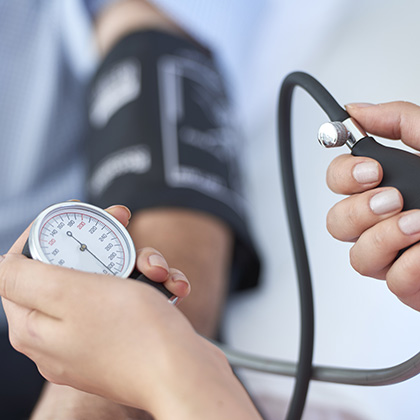Most people will have a nosebleed at some point or other in their lives. According to the National Institute of Health and Care Excellence (NICE), 60 per cent of us have experienced or will experience a nosebleed (i).
Also called epistaxis by medical professionals, a nosebleed can be alarming – particularly for parents when it happens in children. Thankfully, most cases aren’t a sign of anything serious, and if you’re lucky a nosebleed may last for just a few seconds (though they can last up to 10 minutes or longer). The most common time to get a nosebleed is between the age of two and 10 years, as well as after the age of 45 (i). Pregnant women may also have more nosebleeds than normal, as may people taking blood-thinning medication such as aspirin or warfarin. If you have a blood disorder such as haemophilia, you’re also more susceptible to nosebleeds.
There are two types of nosebleeds, each of which depends on where exactly in the nose the bleeding starts.
Anterior bleeds
The most common type is the anterior nosebleed (experts claim the vast majority of nosebleeds are anterior nosebleeds (ii)). This is when the bleeding comes from just inside the nose, usually from the lower septum (the internal wall between the two nostrils). Sometimes there’s no obvious reason for an anterior nosebleed. However, things that usually cause them include a simple trauma to the nose such as a facial injury or picking your nose. This type of nosebleed is also more common during the winter, possibly because it can be caused by blowing your nose when you have a cold. Dry nasal membranes – which can be caused by dry winter air and indoor heating – can also cause anterior nosebleeds if the membranes dry out and crack.
Other things that may cause an anterior nosebleed include hay fever or other allergies, sinusitis, using nasal decongestants, high altitude, cocaine use and a deviated septum.
Posterior bleeds
The other type of nosebleed is a posterior nosebleed, which – while less common – can be more serious and profuse than an anterior nosebleed. In this case, the bleed comes from the deeper structures of the nose. Things that cause posterior nosebleeds include head injuries, nasal surgery, broken nose, atherosclerosis (hardened arteries), nasal tumour, blood clotting abnormalities such as haemophilia and – in rare cases – leukaemia.
People who have frequent or heavy nosebleeds may also have high blood pressure – though experts haven’t found a clear link between the two. Indeed, one study has found that arterial blood pressure is generally higher when you have a nosebleed than at other times (iii). But that doesn’t necessarily mean that there’s an association between nosebleeds and high blood pressure – arguably your blood pressure could become temporary raised during a nosebleed owing to stress.
How to stop a nosebleed
Most nosebleeds can be stopped by following some simple steps. Here’s what you should do:
-
Sit down and tilt your head forwards to let the blood drain from the nostrils (this will prevent blood draining down the back of your throat, which could make you vomit). Breathe through your mouth, and pinch the soft part of your nose, just above your nostrils.
-
Try not to speak, swallow, cough, spit or sniff, as it may disturb any blood clots that may have formed in the nose.
-
Keep pinching your nose, and after 10-15 minute release the pressure. Keep leaning forward and breathing through your mouth.
-
If it helps, put an ice pack or a frozen bag of peas wrapped in a towel on the bridge of your nose. If you don’t have an ice pack or a bag of frozen peas, try placing a cold flannel or compress around your nose and the front of your face. The cold may help close down the blood vessels, which will stop the bleeding.
-
When the bleeding has stopped, clean the area around the outside of your nose with lukewarm water, and take it easy for a few hours while making sure not to tip your head backwards (stay upright rather than lying down). Try not to exert yourself and avoid blowing your nose at all costs – if you do, you may disturb any clots, and your nose may start to bleed again.
Other things you should do after a nosebleed include the following:
-
Don’t lie flat or do any strenuous exercise or heavy lifting for at least 24 hours.
-
As well as not blowing your nose, don’t pick your nose.
-
Try to avoid catching a cold by staying away from people who’ve been infected. Click here to find out more about how to avoid catching a cold virus.
-
If you must sneeze, do so with your mouth open (according to the NHS, this reduces the pressure in your nose).
What happens when you have a nosebleed
Your nasal cavity houses many tiny blood vessels that are so delicate they can easily be damaged and bleed. Here’s a brief glimpse of what goes on inside your nose. Blood is supplied to the nasal cavity by the internal and external carotid systems, with the anterior and posterior ethmoidal arteries and the sphenopalatine arteries carrying the majority of blood to the nasal tissues.
The anteroinferior nasal septum – the bottom of the wall that divides your nasal cavity into two sides – houses an area full of blood vessels, called Kiesselbach’s plexus (also called Little’s area). This is where the majority of nosebleeds (anterior nosebleeds) originate. Kiesselbach’s plexus comprises five arteries. The anterior ethmoidal and posterior ethmoidal arteries are branches of the opthalmic artery, whereas the sphenopalatine and greater palatine arteries are branches of the maxillary artery. The other artery that makes up Kiesselbach’s plexus is the septal branch of the superior labial artery, which is a branch of the facial artery.
Meanwhile, the posterior nasal cavity includes an area called Woodruff’s plexus. This is located over a spongy bone called the posterior middle turbinate and, like Kiesselbach’s plexus, is rich in blood vessels, mostly those connecting branches of the internal maxillary artery. If you have a posterior nose bleed, it often comes from the lateral wall in the posterior nasal cavity, rather than the nasal septum.
When is a nosebleed serious?
If you have a heavy nosebleed and have lost a lot of blood or a nosebleed that doesn’t stop within 10-15 minutes, go to your local hospital’s A&E or call 999 for an ambulance (you can also call 111 for non-emergency medical help). You should also get emergency help if you’re having breathing difficulties with a nosebleed, if you’ve had a serious injury that’s caused a nosebleed (a car crash, for instance), if you feel weak or dizzy or if you’ve vomited after swallowing a lot of blood.
Meanwhile, contact your GP if you have a nosebleed and you’re taking blood-thinning medicines such as aspirin or warfarin, or if you have a disorder that prevents your blood from clotting, such as haemophilia. Similarly, speak to your doctor if you have regular nosebleeds, or if you have regular nosebleeds as well as heart palpitations, breathing difficulties and pale skin (these may indicate anaemia). It’s also advisable to consult your GP if you have a child younger than two years old who has a nosebleed.
Treatments for nosebleeds
If you have recurring nosebleeds or if you have to see your GP or go to hospital with a nosebleed, you may end up having medical treatment. The most usual treatments used to stop nosebleeds are nasal cautery and nasal packing.
Nasal cautery
This involves cauterising (burning) the blood vessel that’s bleeding. It’s a minor procedure often carried out with a silver nitrate stick, which a doctor holds against the area in your nose that’s bleeding for up to 10 seconds to seal the blood vessel. Electrocautery, meanwhile, uses an electrically charged wire – such as platinum – instead of silver nitrate to stop the bleeding. Nasal cautery can be painful, but you should be given a local anaesthetic spray in your nose to make it numb beforehand. This procedure is also only carried out when the source of the bleed can be spotted.
Nasal packing
If your doctor cannot identify where the bleeding is coming from – or if they’ve tried cauterising the bleed and it hasn’t stopped – you may be advised to have your nose packed. This involves placing gauze or nasal sponges in your nose to apply pressure to the area that’s bleeding, thereby stopping the bleed. Again, you will usually have your nose numbed with a local anaesthetic spray. If you have your nose packed, the packing needs to be left in place for two or three days, when you’ll need to see an ENT (ear, nose and throat) specialist to have the packing removed. You may also need a course of antibiotics to make sure you don’t develop a bacterial infection in your nose.
Other hospital treatments include an application of tranexamic acid, which may help stop the bleeding, and an operation called ligation, where the bleeding blood vessels in the back of your nose are tied off. If you’ve lost a lot of blood, you may also need a blood transfusion.
Natural support for nosebleeds
If you have nosebleeds because your nasal passages are dry, there are nasal sprays available that help moisturise the nose, including natural saline sprays. You may also find it useful to apply petroleum jelly or olive oil with a cotton bud to the front of the nose each day to prevent dryness. There are also a few nutritional supplements you could try, including some that may help strengthen the blood vessels.
Vitamin C
This antioxidant vitamin is thought to help with tissue healing and capillary strengthening, since it’s needed for the growth and repair of tissues throughout the body. It also helps your body make collagen, which is essential for healthy skin, cartilage, tendons, ligaments and blood vessels.
This is particularly relevant, since some cases of nosebleeds may be caused by collagen problems, especially in people who take nasal steroids (for allergies), which can thin the collagen in the nasal membranes. Some people have nosebleeds because they have fragile capillaries (other symptoms include bleeding gums and heavy periods) – this too may be caused by weak or damaged collagen in blood vessel walls.
Frequent nosebleeds may also be one of the signs of scurvy, which is a condition that develops when you have a severe vitamin C deficiency.
Anthocyanidins
Plant pigments found in dark and richly coloured fruit such as blueberries, blackberries, raspberries and red grapes, anthocyanidins are powerful antioxidants. Available in supplement form, they are thought to increase the amount of vitamin C in the body as well as help seal up leaky blood vessels by repairing collagen in blood vessel walls and capillaries.
Rutin
A bioflavanoid found in foods such as buckwheat, apples, elderflowers and asparagus, rutin is thought to help strengthen fragile blood vessels, which is why it’s often recommended for nosebleeds.
Meanwhile, some natural supplements may increase your tendency to bleed because of the effect they have on blood clotting. If you’re experiencing more than the occasional nosebleed, take care when using gingko biloba, high-dose vitamin E and garlic supplements.
Experiencing frequent nosebleeds can be worrying, be we hope this guide provides a little reassurance. To discover more articles on a range of common health conditions, simply visit our health library.
References:
-
Available online: https://cks.nice.org.uk/epistaxis-nosebleeds#!backgroundSub:2
-
Available online: https://www.nhsinform.scot/illnesses-and-conditions/ears-nose-and-throat/nosebleed#causes-of-nosebleeds
-
Kikidis. D, Tsioufis. K, Papanikolaou. V, et al. Is epistaxis associated with arterial hypertension? A systematic review of the literature. Eur Arch Otorhinolaryngol. 2013 Mar 29. Available online: https://pubmed.ncbi.nlm.nih.gov/23539411-is-epistaxis-associated-with-arterial-hypertension-a-systematic-review-of-the-literature/
Related Posts
Disclaimer: The information presented by Nature's Best is for informational purposes only. It is based on scientific studies (human, animal, or in vitro), clinical experience, or traditional usage as cited in each article. The results reported may not necessarily occur in all individuals. Self-treatment is not recommended for life-threatening conditions that require medical treatment under a doctor's care. For many of the conditions discussed, treatment with prescription or over the counter medication is also available. Consult your doctor, practitioner, and/or pharmacist for any health problem and before using any supplements or before making any changes in prescribed medications.

Christine
Christine Morgan has been a freelance health and wellbeing journalist for almost 20 years, having written for numerous publications including the Daily Mirror, S Magazine, Top Sante, Healthy, Woman & Home, Zest, Allergy, Healthy Times and Pregnancy & Birth; she has also edited several titles such as Women’ Health, Shine’s Real Health & Beauty and All About Health.
View More



